Star Wars Galactic Battlegrounds Preview
We take an exclusive look at the new Star Wars real-time strategy game.
LucasArts has done the unthinkable. It is returning to the real-time strategy genre with another Star Wars strategy game. Considering the poor reception given to Force Commander less than a year ago, this is a surprising move. But what's really shocking is that LucasArts is seeking outside help for a game that's being developed internally in order to ensure that it gets this second attempt right. It is all part of the plan to finally make a good RTS that truly lives up to the Star Wars name. This game is Star Wars: Galactic Battlegrounds, and it uses the Age of Empires II engine as its backbone. The news bodes well for those who always wanted a fun Star Wars strategy game, and who better than Ensemble Studios to assist LucasArts in making a great real-time strategy game. Ensemble definitely has the experience and success to help LucasArts overcome the mistakes of Force Commander and deliver an RTS game that actually lives up to the promise of epic Star Wars battles.
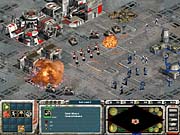
GameSpot recently visited the offices of LucasArts to get a firsthand look at Galactic Battlegrounds. The game has been in development for many months now, and it looks good. You can tell right away that this game is being built with the same engine used to power Age of Empires II, a technology that Ensemble calls genie technology. That's the first time we've heard the Age of Empires II engine referred to by that name, but regardless of nomenclature, it's the same stuff that built Age of Kings. Galactic Battlegrounds is basically Age of Empires II but with Star Wars units and settings. Moreover, the team at LucasArts isn't ashamed to admit that it's using Age of Empires II. As far as they're concerned, they want to keep the same gameplay that made Age of Kings fun but add their own unique Star Wars twist. The benefit of using the Age of Empires II engine is that LucasArts no longer has to waste valuable development time reinventing the wheel. A graphics engine, scripting language, and other technology are already done. What the designers can thus concentrate on is actual design, parlaying their expertise in art, story, and mission design (something LucasArts is very good at) into a better game.
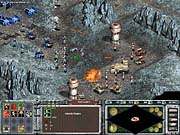
Many gamers will wonder why LucasArts is even bothering, considering Force Commander, but the company has definitely learned from its mistakes. And using the proven Age II engine doesn't hurt. LucasArts is quick to point out that Ensemble is licensing the engine and is not a codeveloper but that it does offer advice and feedback. And as the team leaders on this game pointed out to us, by both learning from their mistakes on Force Commander and using a proven technology, they'll hopefully be able to create a better strategy game. "This is the game that Force Commander should have been, could have been if we didn't commit to 3D. You want to have hundreds of units battling. That's Star Wars. And right now 2D is the only way that you can do that. What we learned on Force Commander has let us do this. We couldn't have done this game in 3D."
So let's take a look at what LucasArts can do with this 2D game.
Graphics and Civilizations
Because Galactic Battlegrounds is based on the Age II engine, it is 2D, but it's detailed and smooth. The graphics look good, and you'll have no trouble discerning the many familiar Star Wars units that populate the game. While the game isn't to absolute scale, it offers a full range of different-sized units, from small storm troopers to large AT-AT walkers. LucasArts says it is creating a lot of art for the game, and there was definitely more artwork than we had time to see. In addition to the more than half a dozen terrain tiles, LucasArts says there are 300 unique units, six campaigns, and six civilizations, and every civilization has its unique set of art. Whereas in Age of Kings, each civilization could build a trebuchet, in Galactic Battlegrounds, each civilization has a trebuchet-like siege weapon, but they all have different names, look different, and even operate a little differently, even though they fill the same niche. And the six sets of unique art don't even include lots of campaign-specific artwork being created just for single-player missions.
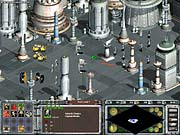
LucasArts felt it was important to make the game easy for gamers to play. To that end, the designers made sure that even though the art for each civilization was unique, the buildings still shared the same silhouettes and shapes so that you could always tell what each building was, even if you were playing a race for the first time. Thus, the troop centers for the different civilizations will have different skins but similar shapes. If you move from playing a Rebel to a Wookie, you won't have to relearn a whole new set of buildings. While they might have different textures and shades, they'll still have the same outlines.
The six civilizations in the game are the Wookies, Gungans, Empire, Rebel Alliance, Trade Federation, and Naboo. Each has a distinct visual style. The Naboo, for example, have buildings that are beautifully carved and sophisticated, with gardens, columns, and intricate arches. The Wookies, in contrast, are a more utilitarian race that live in trees, and their buildings are propped up on stilts and constructed of a hodgepodge of metal and wood. The Gungans have buildings that are bulbous and glowing, with glassy bubbles similar to the underwater Gungan city seen in Star Wars: Episode I - The Phantom Menace.

The different terrain tilesets, representing homeworlds of both the six civilizations and the neutral worlds, are also varied and unique. There are the spice mines of Kessel, icy Hoth, the forests of the Wookie homeworld of Kashyyk, the sands of Tattooine, the cloud city of Bespin, the Naboo capital of Theed, the forest moon of Endor, and even an asteroid space station called Hanoon. These worlds each have a unique look, emphasizing the diversity of the Star Wars universe. The Naboo tileset includes green fields and toppled statues on the ground, while the deserts of Tattooine feature lots of sand and rock, punctuated by roaming herds of bantha. Bespin has a metallic and polished look to it, with great spires and floating metal platforms. The space tileset is reminiscent of the Starcraft space terrain, except that in addition to space platforms there are also large asteroids among the stars. They're also populated with familiar Star Wars fauna, such as taun tauns and wampaas. Even the space setting has neutral creatures--the winged mynocs that flutter around asteroids.
Strong Campaigns
Unlike in Age of Empires II, the single-player campaign here will be rich. The game spans the years from Episode I to Return of the Jedi, although there is of course nothing in the game concerning Episode II or Episode III. The team producer stated, "We explore more parts of Star Wars in this game. We're able to explore things that went on with the Wookies and Gungans. There is a lot more epic story here, bigger stories. We have a lot more voice. Age of Kings had like 800 to 1000 voice lines. We have over 5000."
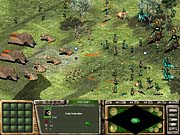
The game has six campaigns, essentially one for each of the six civilizations, and each takes place in a different time. Star Wars games have always been at their best when they included characters from the movies and books in the gameplay, and Galactic Battlegrounds does that in the campaign. In fact, each of the six campaigns revolves around main characters. The first campaign, a tutorial campaign, takes place around the time of Episode I and involves Qui-Gon Jinn and his Wookie friend, Attichitcuk, who is in fact Chewbacca's father. In this campaign, you control Wookies, who are one of the six civilizations. In the second campaign, which takes place during Episode I, you play as a battle droid named OOM-9, who commands a military contingent of the Trade Federation. In the third campaign, you play as the Gungan leader Boss Nass and the Gungans. In the fourth campaign, you control the forces of the Empire and command Lord Darth Vader. The fifth campaign involves the Rebel Alliance, where you assume leadership as Princess Leia. Finally, in the sixth campaign, you play as Chewbacca and lead a real Wookie army.
The campaign missions themselves include puzzle missions, treasure-hunt missions, resource-collection missions (mostly for the Trade Federation campaign), and search-and-destroy missions, such as having to destroy an enemy shield generator. LucasArts is spending lots of time designing custom art and details for the scenarios. For instance, in a re-creation of the Hoth scene from The Empire Strikes Back, you'll see a working ion cannon and echo base. In the Chewbacca campaign, you'll actually get to free the Wookies from enslavement and fight the reptilian Trandoshans, who are being created specifically for the campaign.
Each campaign also has a bonus mission that explores "what-if" possibilities from the movies. For example, in the Imperial campaign, you get to play as Darth Vader after he learns of Lando's treachery in rescuing Luke from Bespin. You thus get a mission where you return to Bespin to destroy it in retribution for Lando's actions. On the Trade Federation side, you might have a mission that assumes that Anakin didn't destroy the control ship, and so you get to play a mission where you keep on battling the Gungans until you destroy every last one of them. And of course, during the campaigns, you'll get to control your favorite Star Wars characters, such as Darth Vader and Jar Jar Binks, who appear as hero units in the campaign.
Gameplay
Galactic Battlegrounds obviously shares many qualities with Age of Empires II. LucasArts says that one thing it wanted to do was keep the game types and gameplay of Age of Kings, to satisfy the Age players who might want to play Galactic Battlegrounds, while also offering new Star Wars elements for Star Wars fans. Thus, everything you could do in Age you can also do here. You can build great wonders to win the game, although to be consistent with the unique art for each culture, each wonder has a unique look to it. In addition, the relics scattered about the map in Age of Kings are also here, although in this game they are called Jedi holocrons and can be picked up only by Jedi knights.
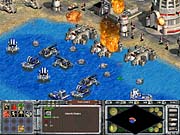
As in Age of Kings, each civilization in Galactic Battlegrounds has a unique unit. And also as in Age of Kings, you have to advance through four age levels to gain new units and technologies. However, in Galactic Battlegrounds, the designers are referring to the ages as tech levels one through four instead. The interface has changed somewhat for Galactic Battlegrounds. LucasArts brought the top banner of information, detailing the resources, down to the bottom interface bar. And there is now a section just above the unit and building information display that shows relevant information about the selected unit or structure, such as whether the object has shields, whether it needs power (if it's a building), whether it has stealth technology, and whether it is a detector unit. These changes and minor additions aren't big, but they do make the game a bit more user-friendly and intuitive.
The game has four resources, but of course they are named differently and operate a little differently as well. The four resources are food, carbon, nova crystals, and ore. Carbon is like wood, in that you use it primarily to create buildings and also some units. Food and carbon are more important in the early tech levels, while nova crystals and ore are more important in the later tech levels. Nova crystals are roughly analogous to gold and are used to buy lots of high-end upgrades and units, such as Jedi. Carbon deserves added mention because it comes from multiple sources. You can gather it from trees or from columns of rock. The reason LucasArts decided to allow different sources for this resource is because it would look silly if you had to chop down trees on Tattooine or Hoth for wood. There are no trees in the deserts or arctic. So instead, these terrain types will have carbon rocks. Snow and desert terrains aren't the only tilesets with tailored resources. On the space maps, for instance, you won't find crystals and other resources growing from metal platforms, as you do in Starcraft. Instead, on the space maps, the resources will appear as great shipments or crates of resources, thereby blending in logically with the terrain.
There's also a small addition to food gathering in Galactic Battlegrounds. You can still create farms, but you can also herd animals, such as banthas and nerfs, into an animal nursery. Here, instead of killing the animals for quick and immediate shots of food, you can get a slow trickle of food. The upside is that you don't kill the animal, but the drawback is that you get food at a much slower rate.
The Units
Galactic Battlegrounds' big draw, of course, is being able to control hundreds of familiar Star Wars units in great battles, and this game has lots of them. The game's units are a combination of existing units pulled from the movies, units that were designed but didn't make it into the films, and units that the design team created on its own. Unlike in Age of Kings, there aren't universal units that are shared by all civilizations. Instead, each civilization has a unique set of units. The Trade Federation, for example, has lots of droids in its armies, such as regular battle droids, destroyer droids, and hovertanks. The Empire, in contrast, has storm troopers, AT-ST walkers, probots, and so on. Although each civilization has its unique set of units, they do fall roughly into general categories.
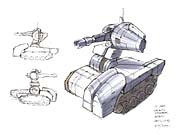
Instead of having barracks, archery ranges, and stables, Galactic Battlegrounds has such buildings as the troop center and mech factory. These last two are examples from the Imperial side, and the names are slightly different for each civilization. At the troop center, for example, you create simple infantry-type units. From here you can build probots, storm troopers, grenade troopers (a new unit), mounted troopers (for the Empire the mounted troopers ride dewbacks, while on the Rebel side they ride taun-tauns). And of course, as you advance through tech levels, you can get better versions of these units or access new types of units entirely. At the mech factory, you can build scout mechs, air scouts, single-pilot mechs, dual-pilot mechs, armored transports, and so on. Although these names sound generic, LucasArts says that to keep gameplay easy to understand, it is opting not to use complicated names. For game balance purposes, each civilization's units, despite appearances, are meant to be roughly equivalent. Thus, when you build a unit that is good against mechs or good against troopers or good against air units, you should know right away what class of units actually fall into those categories. It would be frustrating to have to flip through the manual to see whether a Gungan kadu is a mech-type unit while in the middle of a pitched battle. While the more basic naming convention sounds uninspired, we can see the logic in going this route, especially if it makes the game more balanced and easier to play.
In addition to these units, Galactic Battlegrounds also has air units. Each civilization has a fighter or several fighter-type aircraft, as well as a bomber and troop transport. On the Rebel side, for instance, the Z-95 headhunter is the early-age fighter, while the X-Wing is the later-age fighter. The Empire, as you might guess, has TIE fighters and TIE bombers as its air units. Because air units are a completely new addition to the Age of Empires II engine, the design team had to tweak the engine somewhat to add them, but the air units seem to fit naturally into the game. To counter air units, the game is introducing missile units and antiair turrets.
Other interesting units in the game are Jedi and bounty hunters. Although Jedi ordinarily would be restricted to just the Imperial and Rebel civilizations, again, in the interest of game balance, each side has a Jedi unit to build. And they are all different. The Empire, for example, can build black warriors with dual light sabers that bear an uncanny resemblance to Darth Maul, while the Rebel Jedi are the more traditional cloaked Jedi with single lightsabers. The Jedi in Galactic Battlegrounds are like superpriests. They can convert enemy units to your side, but they also have a powerful melee attack. They are thus a rarity in Galactic Battlegrounds, since most units in the game are ranged units with blasters and firearms. You can also research several upgrades to Jedi, including invisibility, detection ability, and enhanced speed. Jedi are powerful, but they have a counterunit in this game: bounty hunters, which are units with special abilities designed for taking down Jedi.
Jedi, Bounty Hunters, and Unique Units
As noted previously, each civilization has units that fulfill similar roles but that look unique. However, each civilization also has a true unique unit, similar to the unique units from Age of Kings. The Trade Federation's unique unit is the destroyer droid. The Empire's unique unit is the dark trooper, from the Dark Forces action game. The Naboo's unique unit is the royal knight. The Rebel's unique unit is the snow speeder from the Empire Strikes Back. The Gungans' unique unit is the fambaa shield generator, those hulking dinosaurs that carried great portable shield generators on their backs. The Gungans are thus the only civilization that has mobile shields. Finally, the Wookie unique unit is the berserker, a powerful raging Wookie that can regenerate hit points.
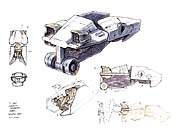
These unique units are built at the fortress, the Galactic Battlegrounds equivalent of the castle. The fortress, in addition to housing your unique units and having antiair missile capabilities, is also where you build your blaster cannon, which is the equivalent of the trebuchet. This siege weapon unpacks and packs itself and can fire devastating energy at far-off targets. Each civilization's blaster cannon looks different. The Empire, for instance, has a hovercraft with a great focusing dish on top of it. When it fires, three green beams form into one massive beam that then strikes the target, in very similar fashion to the Death Star. The Trade Federation, in contrast, has a blaster cannon that looks like a massive destroyer droid. When it packs up, it turns into a ball that rolls along the terrain. When it unpacks, it uncurls like the destroyer droid and starts firing its two massive arm cannons.
Galactic Battlegrounds also has sea units, including warships and submarines. And because this is Star Wars, this game has many sci-fi conventions as well. For example, you can research stealth technology and attack while invisible. Like in Starcraft, you'll need detector units to spot the invisible units or you won't be able to locate them. There are also shield generators you can build to protect both buildings and units. Units equipped with shields effectively have double hit points, while buildings with shields are more resistant to attack. In many cases, you will have to destroy the shield generators before you can effectively destroy an enemy town. Another new consideration for gameplay is the need for power. Like the Protoss in Starcraft, the different civilizations will have power needs, and you'll have to build your structures near power cores. However, unlike in Starcraft, buildings will still function, albeit at quarter efficiency, if they are beyond power cores or their nearby power cores are destroyed.
During our exclusive look at Star Wars: Galactic Battlegrounds, we saw a game that seemed to be a promising blend of two worlds. On the one hand there was the tried-and-true engine and gameplay of Age of Empires II. On the other hand there was the storytelling, art, and design of the seasoned Star Wars designers. LucasArts is certainly hoping that Galactic Battlegrounds combines the best of both worlds. And from what we saw, the game clearly is on its way to being a unique blend of classic RTS gameplay and Star Wars fun. It's already much better than Force Commander, and it could very well be as good as, if not better than, Age of Empires II. If LucasArts continues to polish and improve the game, then when it hits store shelves in November of this year, it could be the real Star Wars strategy game we've all been waiting for.
Got a news tip or want to contact us directly? Email news@gamespot.com
Join the conversation